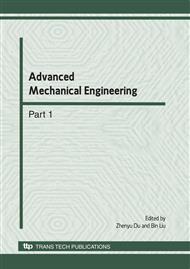[1]
Z. W. Li and M. C. Zhou, Deadlock Resolution in Automated anufacturing Systems: A Novel Petri Net Approach, London: Springer-Verlag, Feb. (2009).
Google Scholar
[2]
Z. W. Li, M. C. Zhou, and N. Q. Wu, A survey and comparison of Petri net-based deadlock prevention policies for flexible manufacturing systems, IEEE Trans. Syst., Man, Cybern., C, Appl. Rev., vol. 38, no. 2, pp.173-188, Apr. (2008).
DOI: 10.1109/tsmcc.2007.913920
Google Scholar
[3]
F. Chu, X.L. Xie, Deadlock analysis of Petri nets using siphons and mathematical programming, IEEE Trans. Robot. Autom., 1997, 13(6): 793-804.
DOI: 10.1109/70.650158
Google Scholar
[4]
Yisheng Huang, MuDer Jeng, Xiaolan Xie, and Shengluen Chung, Deadlock prevention policy based on Petri nets and siphons, International Journal of Production Research, 2001, 39(2): 283-305.
DOI: 10.1109/robot.2001.932606
Google Scholar
[5]
Z. W. Li and M. C. Zhou, Two-stage method for synthesizing livenessenforcing supervisors for flexiblemanufacturing systems using Petri nets, IEEE Trans. Ind. Inf., vol. 2, no. 4, pp.313-325, Nov. (2006).
DOI: 10.1109/tii.2006.885185
Google Scholar
[6]
A. Giua and C. Seatzu, Modeling and supervisory control of railway networks using Petri nets, IEEE Trans. Autom. Sci. Eng., vol. 5, no. 3, pp.431-476, Jul. (2008).
DOI: 10.1109/tase.2008.916925
Google Scholar
[7]
Z. W. Li and A. R. Wang, A Petri net based deadlock prevention approach for flexible manufacturing systems, Acta Automatica Sinica, vol. 29, no. 5, pp.733-740, (2003).
Google Scholar
[8]
Z. W. Li, M. C. Zhou, and M. D. Jeng, A maximally permissive deadlock prevention policy for FMS based on Petri net siphon control and the theory of regions, IEEE Trans. Autom. Sci. Eng., vol. 5, no. 1, pp.182-188, Jan. (2008).
DOI: 10.1109/tase.2006.884674
Google Scholar
[9]
Z. W. Li and M. C. Zhou, On siphon computation for deadlock control in a class of Petri nets, IEEE Trans. Syst., Man, Cybern., A, Syst., Humans, vol. 38, no. 3, pp.667-679, Jun. (2008).
DOI: 10.1109/tsmca.2008.918605
Google Scholar
[10]
X. L. Liu, A. R. Wang, and Z. W. Li, A fast algorithm to find a set of elementary siphons for a class of Petri nets, in Proc. IEEE Int. Conf. Autom. Sci. Eng., Shanghai, China, Oct. 7-10, 2006, pp.399-404.
DOI: 10.1109/coase.2006.326915
Google Scholar
[11]
A. R. Wang, Z. W. Li, J. Y. Jia, and M. C. Zhou, An effective algorithm to find elementary siphons in a class of Petri nets, IEEE Trans. Syst., Man, Cybern., A, Syst., Humans, vol. 39, no. 4, pp.912-923, Jul. (2009).
DOI: 10.1109/tsmca.2009.2019880
Google Scholar
[12]
J. Ezpeleta, J. M. Colom, and J. Martinez, A Petri net based deadlock prevention policy for flexible manufacturing systems, IEEE Trans. Robot. Autom., vol. 11, no. 2, pp.173-184, Apr. (1995).
DOI: 10.1109/70.370500
Google Scholar
[13]
T. Murata, Petri nets: Properties, analysis, and applications, Proc. IEEE, vol. 77, no. 4, pp.541-580, Apr. (1989).
DOI: 10.1109/5.24143
Google Scholar


